|
F6F-5N Night Fighter
Weekend Edition
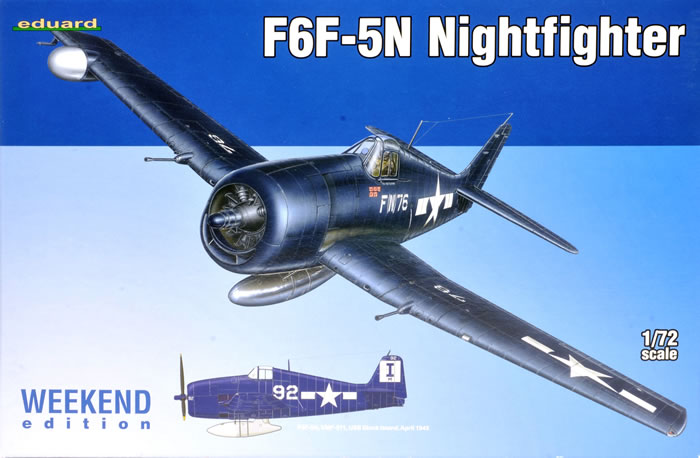
Eduard, 1/72 scale
S u m m a r y : |
Catalogue Number: |
Eduard it No. 7434 - F6F-5N Nightfighter |
Scale: |
1/72 |
Contents & Media |
Fifty-one grey and five clear styrene parts, with decals for two subjects. |
Price: |
On-line Stockist |
Price |
Eduard |
US$16.95 |
Hannants |
£8.33 |
Squadron |
US$16.95 |
Modelimex |
€8.47 |
Hobby Link Japan |
¥1,350 |
Lucky Model |
US$11.99 |
For currency conversion click here. |
Review Type: |
First Look. |
Advantages: |
Eduard’s base kit is the best 1/72-scale Hellcat available. This edition includes cannon-armed option, which adds interest and variety. |
Disadvantages: |
Lack of flame damper exhausts; the need to make the pilot’s radar scope is not mentioned. |
Conclusions: |
Eduard’s Hellcats are the best available in ‘The One True Scale’, so it is no surprise that that their Weekend Edition of the F6F-5N kit is a superb kit. It is very accurate, has excellent levels of detail and very good fit, and is excellent value.
If you dislike PE or do not want the extra detail level it can provide then this is the kit for you rather than the more costly Profipack Edition.
This kit is straightforward and pleasurable to build; so if you find that Hellcats, nighfighters, US Navy or Royal Navy carrier-borne aircraft spin your wheels, then I definitely recommend you buy it. |
Reviewed by Mark Davies

Eduard's 1/72 Avia B.534 IV serie Profipack Edition is available online from Squadron.com
The outstanding success of the F6F as a carrier-borne day fighter is widely known. Perhaps less well known is its success as a nightfighter. A response was needed to increased rate of Japanese air activity at night. This was due to the US Navy’s air superiority by day; due in no small part to the introduction of the Hellcat. This led to development of carrier-borne nightfighters; which the US Marines would also use from land bases.
The US Navy fitted radar to a number of aircraft types in response to this nocturnal threat; one of which was the Hellcat. It shone in this new role and became the most successful US nightfighter type; going on to become the mount of several night aces.
The last F6F-5N was withdrawn from Navy service in September 1953; VC-4 being the last unit to use the type.
Choice of Boxings
I think that it is safe to say that most modellers view Eduard’s 1/72 Hellcat kits, first released in August 2011, as the best available in ‘The One True Scale’. I certainly believe this to be so. They come in several boxings that cover various versions of the F6F, generally as Weekend and Profipack Editions, although from time to time Overtrees are offered too.
Weekend Editions offer just the base kit and one or two decal options. Profipack Editions add coloured and plain PE details, a canopy mask, and usually four of five decal options to the base kit. Overtrees are only available from Eduard’s on-line store, and consist of the base kit in a basic box without decals, instructions, or any other extras. All three are tremendously good value for money in my view. Eduard also produces a range of accessories for their Hellcat kits.
The Contents
The parts come in a sturdy top-opening box with the decals, clear and coloured sprues bagged individually in clear re-sealable cellophane. The instructions are printed on glossy paper as a booklet, and include a parts map, clear assembly drawings, colour printed markings guide and a monochrome stencil placement guide. These can be viewed or downloaded as a PDF by clicking here. At the build’s completion there will be spare bombs, rockets and other bits left over because several different boxings are covered by the same sprues.
There have been plenty of articles on the Eduard Hellcat kits here on HyperScale, such as Brett Green’s first look review of the F6F-5 Profipack Edition in late 2011, and mine of the F6F-5N Profipack and F6F-3 Weekend Editions in 2012. I will therefore keep my observations brief because of the ground that has been covered before.
A very well detailed cockpit has the choice of a smooth or raised detail instrument panel, the former’s dial detail being provided as a decal. A pilot’s harness is also provided as decals; which I think are best cut out and left on their backing paper for a more 3D effect than just decal film can provide. They are more than adequate for a closed canopy model, and tolerable for an open canopy.
The kit provides two clear sliding hoods to properly cater for open or closed options. All of the transparent parts are thin, crisp, and very clear.
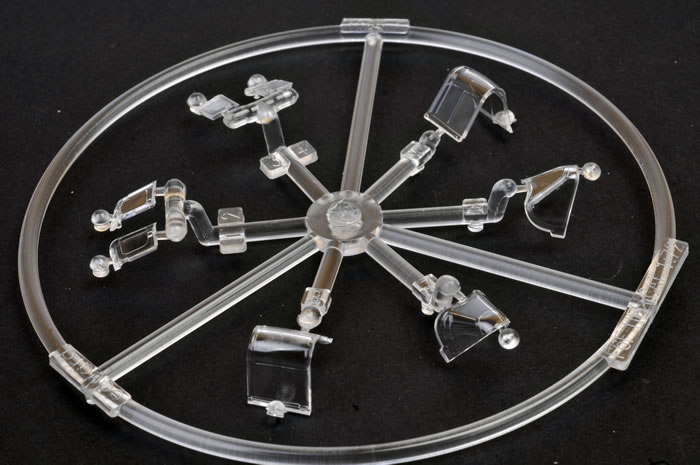
Surface detail is exquisite, consisting mainly of crisp and refined recessed panel lines, it also includes the lapped effect of the real paneling on the fuselage sides. A nicely detailed engine and prop are also provided, and the Hellcat’s distinctive cowl shape when viewed head on is well captured.
A nice touch is the way the choice of ribbed or diamond treaded tyres are moulded separately from the wheel rims, making painting of these items a breeze. I am slightly less impressed with the tail wheel which is moulded with its leg attached solidly to the wheel door by a web of plastic, rather than having a gap between the leg and door as might have been possible using two parts. The web area can be shadowed with a wash, or the door and web removed and replaced with a plastic-card item.
Now to the features that apply to the nightfighter version, which is not that many, as very little in terms of parts is needed to transform the standard F6F-5 kit to an F6F-5N.
The most obvious feature is of course the radar pod mounted outboard on the starboard wing. This is a simple two-part assembly that slides over the wing leading edge. The kit instructions include a plan with dimensions to guide its placement.
The kit lacks the radar-scope, so it necessary to cut a short length of plastic rod to fit to the instrument panel. The F6F-5N Profipack Edition’s instructions mention this, as the kit includes a coloured PE face for the scope; but somewhat surprisingly, no mention is made of it in the Weekend Edition.

The instruction advise to fill the rocket mounting holes in the lower wings, although many photos F6F-5N’s show the with the zero-length launch stubs of the standard F6F-5 retained. Unfortunately, the kit’s launch-stubs are attached to the rockets, so you may want to consider scratch-building some.
One of the two decal options has a pair of 20-mm cannons in place of their innermost .50” machineguns in each wing. These fit over the wing leading edge where the machineguns were after they have been cut away.
There are no flame damper exhausts, which may be because they were frequently removed in service. Their absence may have simplified the tooling, but I think that they should have been included. Fortunately flame dampers are not too hard to make if needed.
I can report that the kit is a pleasure to build, as I built the Profipack Edition of the F6F-5N and wrote a brief build article for HyperScale almost four years ago. The parts breakdown is straightforward and the fit very good. One small point I would mention is that the antenna mast hole is offset slightly to port from the centerline. This is not a case of half-hole missing from the starboard fuselage as I thought was the case when I built mine, the mast is supposed to be just offset very slightly to port.
Colours & Markings
The two decal options are both painted overall navy blue. They are the same as two of the four F6F-5N Profipack Edition schemes, these being:
- F6F-5N (with 20-mm cannon) of Maj. Bruce Porter, CO of VMF(N)-542, Yontan Airfield, Okinawa, May, 1945.
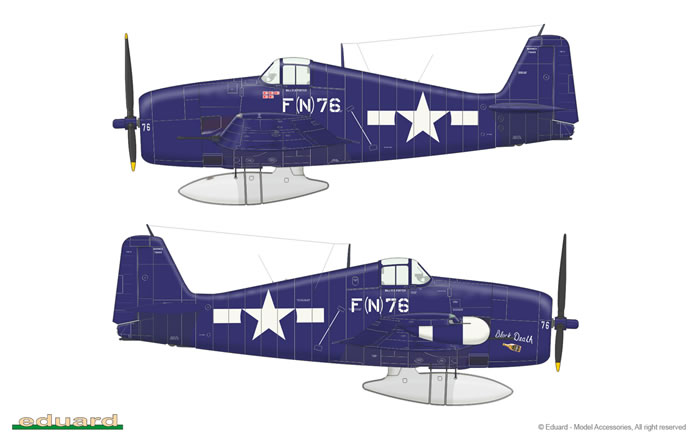
- F6F-5N of VMF-511, USS Block Island, April 1945.
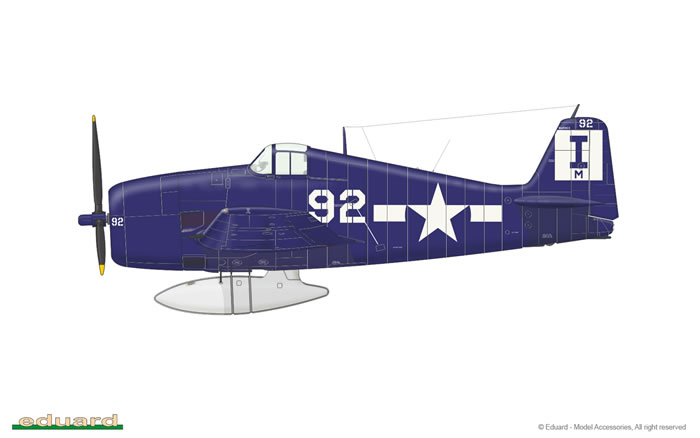
The kit’s colours and markings guide is cross-referenced to the Gunze Aqueous and Mr. Color brands of paint.
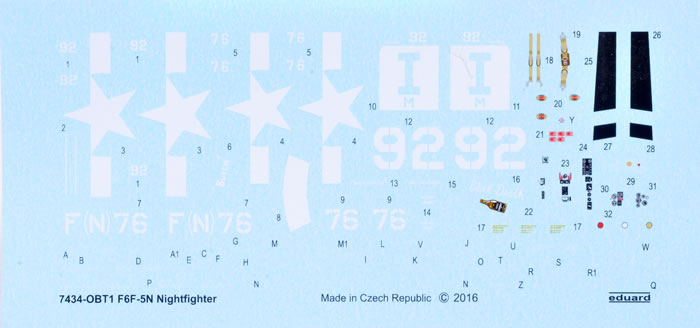
They describe the overall colour as being Navy Blue, but do not provide FS.595 codes. This is a minor point as most will be familiar with the paint brands quoted or know the correct colour to use. The kit decals appear to be of excellent quality.
Eduard’s Hellcats are the best available in ‘The One True Scale’, so it is no surprise that that their Weekend Edition of the F6F-5N kit is a superb kit. It is very accurate, has excellent levels of detail and very good fit, and is excellent value.
If you dislike PE or do not want the extra detail level it can provide then this is the kit for you rather than the more costly Profipack Edition.
This kit is straightforward and pleasurable to build; so if you find that Hellcats, nighfighters, US Navy or Royal Navy carrier-borne aircraft spin your wheels, then I definitely recommend you buy it.
Thanks to Eduard for the sample
Review Text Copyright © 2016 by Mark Davies
Page Created 28 June, 2016
Last updated
28 June, 2016
Back to HyperScale Main Page
Back to Reviews Page |
